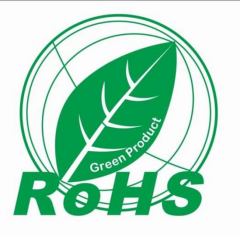service items
ROHS

RoHS certification is the abbreviation of "The restriction of the use of certain hazardous substances in electrical and electronic equipment" (The restriction of the use of certain hazardous substances in electrical and electronic equipment). ROHS certification is also called environmental protection certification, which complies with European and American standards. It stipulates that the EU will ban the import of harmful heavy metals such as lead, cadmium, mercury, hexavalent chromium, polybrominated diphenyl ethers and polybrominated biphenyls in electrical and electronic products from July 1, 2006.
Introduction to ROHS Directive
On January 27, 2003, the European Parliament and the Council of the European Union passed Directive 2002/95/EC, the Restriction of the Use of Certain Hazardous Substances in Electrical and Electrical Equipment (The Restriction of the Use of Certain Hazardous Substances in Electrical and Electrical Equipment). Electronic Equipment), referred to as the RoHS directive. The basic content is: starting from July 1, 2006, the use of lead, mercury, cadmium, hexavalent chromium, polybrominated biphenyls (PBB) and polybrominated diphenyl ethers (PBDE) will be restricted in the newly launched electrical and electronic equipment products on the market. Six harmful substances. After the issuance of the RoHS directive, it became an official law within the EU on February 13, 2003; before August 13, 2004, EU member states converted to national laws/regulations; on February 13, 2005, the European Commission re-examined The directive covers the scope and takes into account the development of new technologies, and drafts additional items in the list of prohibited substances; after July 1, 2006, the EU market will officially prohibit the sale of products with six types of substances exceeding the standard.
ROHS latest directive
The European Union issued the latest ROHS Directive 2011/65/EU on July 1, 2011, updating the previous Directive 2002/95/EC.
Compared with the original directive, the 2011/65/EU directive differs from the original RoHS directive (2002/95/EC) mainly in:
1. The product range has been expanded to cover all electrical and electronic products within the scope of the directive control (including cables and spare parts), and category 8 products "medical equipment" and category 9 products "monitoring and monitoring" have been added. Control equipment includes industrial monitoring and control equipment". The transition period for medical equipment, monitoring and control equipment is July 22, 2014, the transition period for external diagnostic medical equipment is July 22, 2016, and the transition period for industrial monitoring and control equipment is July 22, 2017. In addition, 20 exemptions are given for these two types of products;
2. Clarified some definitions, deleted the definition of "manufacturer", and added the definitions of "manufacturer", "authorized representative", "importer", and "seller", and clarified their responsibilities At the same time, it is stipulated that manufacturers and importers must continue to register electronic and electrical products that do not meet the requirements of the directive and recalled, and pass relevant information to the seller;
3. The scope of controlled substances has not been expanded, and the original limit requirements of the original six substances have been maintained. However, it has been proposed that in the future review process, HBCD and bis(ethylhexyl) Substances such as phthalate (DEHP), butyl phenyl phthalate (BBP), and dibutyl phthalate (DBP) are prioritized for inspection, paving the way for the directive to expand the scope of controlled substances in the future;
4. CE Marking and Declaration of Conformity. Before placing EEE products on the market, the manufacturer/importer/seller must ensure that the relevant assessment has been carried out in accordance with the conformity assessment procedure of 768/2008/EC Appendix II, Module A, and must Affix the CE mark on the final product. The relevant technical documents and EU declaration of conformity shall be retained for at least 10 years. A template for the declaration of conformity is given in Appendix VI of the directive.
This Directive will take effect on the 20th day of its issuance on OJ, and member states need to transform it into national law before January 2, 2013. Directive 2002/95/EC and the amendments listed in Part A of Appendix VII from 2013 Repealed on January 3, 2010.
BCTC accepts the scope of RoHS certification
"Electronic and electrical equipment" in the RoHS Directive refers to equipment that is designed to use AC voltage not exceeding 1000V and DC voltage not exceeding 1500V, and equipment that depends on current or electromagnetic fields for normal operation and that realizes the generation, transmission and measurement of these currents and magnetic fields equipment.
BCTC accepts the scope and classification of RoHS certification:
Type specific equipment
1. Large household appliances, large refrigeration appliances, refrigerators, freezers, and other large food refrigeration, preservation and storage appliances;
Washing machine, clothes dryer;
Dish washing machine, cooking equipment, electric stove, electric hot plate, microwave oven, other large cooking and food processing appliances;
Electric heating appliances, electric heaters; other large heating appliances for rooms, beds, and seating furniture;
Electric fans, air-conditioning devices, other blowing, ventilation and air-conditioning equipment
2. Small household appliances, vacuum cleaners, carpet cleaners, and other cleaning appliances;
Sewing, knitting, knitting and other textile processing appliances;
Irons and other ironing, rolling and other clothing care appliances,
Ovens, frying pans, grinders, coffee machines and equipment for opening or sealing containers or packages;
Electric knives, haircuts, hair blowing, tooth brushing, shaving, massage appliances and other body care appliances;
Clocks, watches and other instruments for measuring, indicating or recording time;
scale
3. IT and communication products centralized data processing: mainframe, minicomputer, printer unit;
Personal computing: personal computers (including CPU, mouse, screen and keyboard), laptop computers (including CPU, mouse, screen and keyboard), notebook computers, notepad computers;
Printers, copying equipment, electric and electronic typewriters;
Pocket and desktop computers, other products and equipment that collect, store, process, demonstrate or communicate information electronically;
User terminals and systems;
Fax machines, telegraph machines, telephones, pay phones, cordless phones, mobile phones, answering systems, and other products or equipment that transmit sound, image transmission or other information via telecommunication






 telephone:
telephone: Phone:
Phone: Email:
Email: Address:
Address: